This is the Trumpeter 01587 kit in 1/35 scale, of the ‘Krupp/Ardelt Waffentrager 88mm PaK 43’.

This is the Trumpeter 01587 kit in 1/35 scale, of the ‘Krupp/Ardelt Waffentrager 88mm PaK 43’.

This is the Tamiya 35292-3200 kit in 1/35 scale, of the ‘German Panzerkampfwagen II Ausf. A/B/C (French Campaign)’.
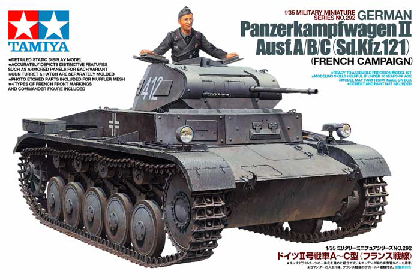
This is the Tamiya 35020-2200 kit in 1/35 scale, of the ‘German Hanomag Sd.Kfz.251/1’.
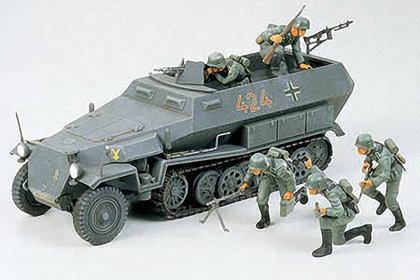
This is the Tamiya 35 376-3800 kit in 1/35 scale, of the ‘American Tank Destroyer M18 Hellcat’.
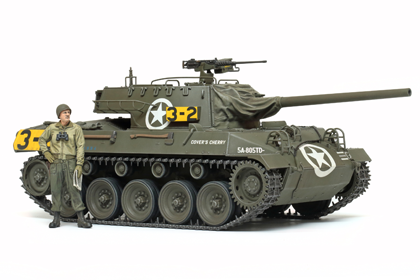
The M18 Hellcat was an American tank destroyer developed to counter the German Army tanks, and it featured an open top design turret and powerful 76mm gun, plus a main gun breech rotated 45 degrees around the gun barrel to save space in the turret interior.
It had a compact, lightweight hull, automatic transmission and the first torsion bar suspension seen on U.S. armor. Its radial 9-cylinder engine at the hull rear was capable of 80 km/h maximum speed which was the highest speed among tracked vehicles during WWII.
The production started in July, 1943 and the Hellcat was in service for the first time at the Italian Front in 1944. After that, this tank destroyer was deployed in the North-Western European and Pacific War theaters, notably besting the German Army tanks with super performance and firepower based on hit-and-run tactics. The Hellcat contributed to U.S. victory as a pioneer of tank destroyers.
Source: Tamiya website
This is the Tamiya 35 374-4000 kit in 1/35 scale, of the ‘German Panzerkampfwagen IV, Ausf. F’.

In service throughout WWII, the Pz.Kpfw.IV was a durable servant to the German Army.
The Ausf. F was the last variant to utilize a short-barreled gun: the L/24 7.5cm KwK37, and was also equipped with wider tracks to cope with the increasing thicknesses of armor.
470 Ausf. F Pz.Kpfw.IVs were manufactured between May 1941 and February 1942, mainly seeing action on the Eastern Front and in North Africa and taking on enemy armor such as the Soviet KV tanks and the British Matilda.
Source: Tamiya website
This is the Tamiya 35 367 kit in 1/35 scale, of the ‘German Heavy Self-Propelled Howitzer Hummel (Late production)’. History The Hummel was developed by German designers in short time, intended to provide a quick boost for troops that had … Continue reading
This is the Tamiya 35 375 kit in 1/35 scale, of the ‘Russian Heavy Tank KV-2’.

In December 1939 the KV-1 was officially adopted by the Soviet military; it was followed by the KV-2, a heavier design based upon the KV-1 chassis, but upgunned to a 152mm howitzer with the intention of breaking enemy strongholds.
In order to accommodate the larger gun, the KV-2 was given a remarkably tall turret. Around two hundred were produced, and supply to the military began in July 1940.
The following June, Nazi Germany invaded and the KV-2 – while suffering a number of breakdowns – took part in Soviet resistance against the invaders, their 152mm guns and impressive survivability enabling some amazing feats, helping stem the tide.
Source: Tamiya website
This is the Tamiya 35 353 kit in 1/35 scale, of the ‘German Brummbär (Late production)’.
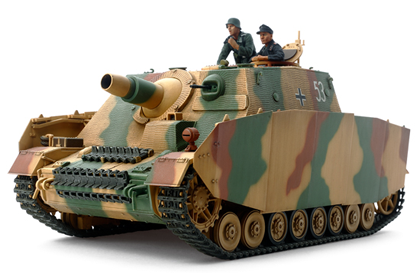
Developed for infantry support during WWII, the Assault Tank IV married the trusty Pz.Kpfw.IV chassis with a simple fighting compartment featuring 100mm of front and 50mm of side armor, plus a high-powered 15cm gun that could defeat 160mm of 30-degree armor from 5km.
Its variants can largely be grouped into early, mid and late production types, the latter of which was most numerous with 160 examples manufactured between May 1944 and March 1945. Feedback from crews of earlier Brummbärs had led to new a fighting compartment design and cupola, plus partial use of steel road wheels.
Brummbärs were assigned to their own dedicated Assault Tank Battalions and fought on the Eastern Front and in Italy as the war drew to its conclusion.
Source: Tamiya website
This is the Tamiya 35 370 kit in 1/35 scale, of the ‘German Tank Destroyer Marder I’.
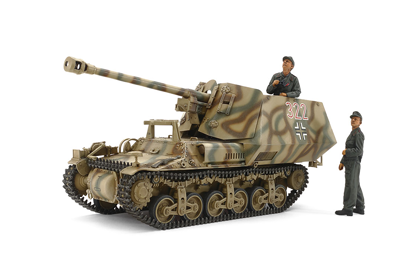
With the fall of France in June 1940 Nazi Germany came into not only new territory, but also a large amount of captured materiel.
Many of the French armored vehicles were pressed into German service, including the Marder I. It was based upon a late-1930s Lorraine tractor vehicle, paired with the German 7.5cm anti-tank gun and based in a new fighting compartment installed on top.
The Marder I fought on numerous fronts in WWII and its offensive potential made it a foe for Allied forces to fear.
Source: Tamiya website
This is the Tamiya 35 372 kit in 1/35 scale, of the ‘Russian Heavy Tank KV-1 Model 1941 (Early production)’.
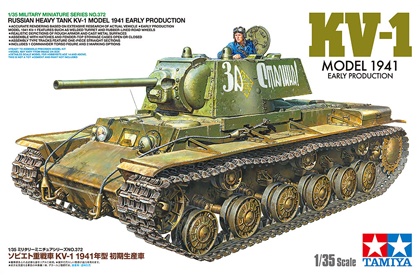
The Soviet KV-1 was officially adopted in 1939 and went through a number of variants. Model 1941 KV-1s employed the 76.2mm ZIS-5 gun, which could tear through the armor on contemporary German tanks.
The early production variants had a welded turret with armor up to 75mm thick, and hung tough in fierce fighting with German armor following the Nazi German invasion of the Soviet Union in June 1941, contributing to the Soviet resistance that would eventually turn the tables and push back the German advance.
Source: Tamiya website
![]()
This is the Eduard, photo etch set for the ‘German 280mm, Railroad Gun, Leopold‘ from Trumpeter.
Detail set |
Trumpeter |
||||
| (35 678) | Basic | ✓ | |||
Source: Eduard